Hi from the Bay of Plenty! After seven weeks away, we have returned to New Zealand! We felt like we structured our time away really well. Taking our round-trip flight home through Sydney gave us a chance to spend time in Australia on both ends of our trip, while breaking up our return journey. And the additional week in Australia was truly a highlight! We did our first Workaway1 stay in Stanwell Park, a stunning coastal town. It is about an hour south of Sydney by train, and just outside of the gorgeous Royal National Park. We stayed with a retired lawyer who now spends most of his time making whimsical pottery, restoring the native bush around his home, and translating books/news articles between Spanish and English.
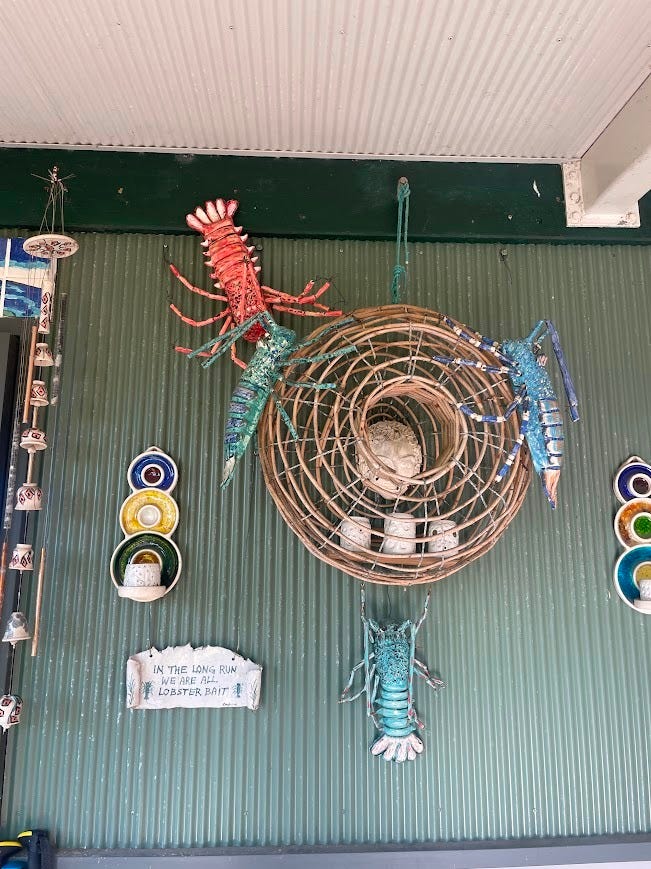
We were initially drawn to our host’s profile due to the Spanish connection, as well as the nature of the work. His main use of Workaway is to recruit other volunteers for the littoral rainforest restoration project he leads near his home of 50 years. After our negative experience being unpaid labor for a luxury lodge, the idea of doing Workaway in support of public space felt really appealing. We also initially thought we might take the train into Sydney, but we ended up enjoying the outskirts so much that we didn’t go back into the city center!
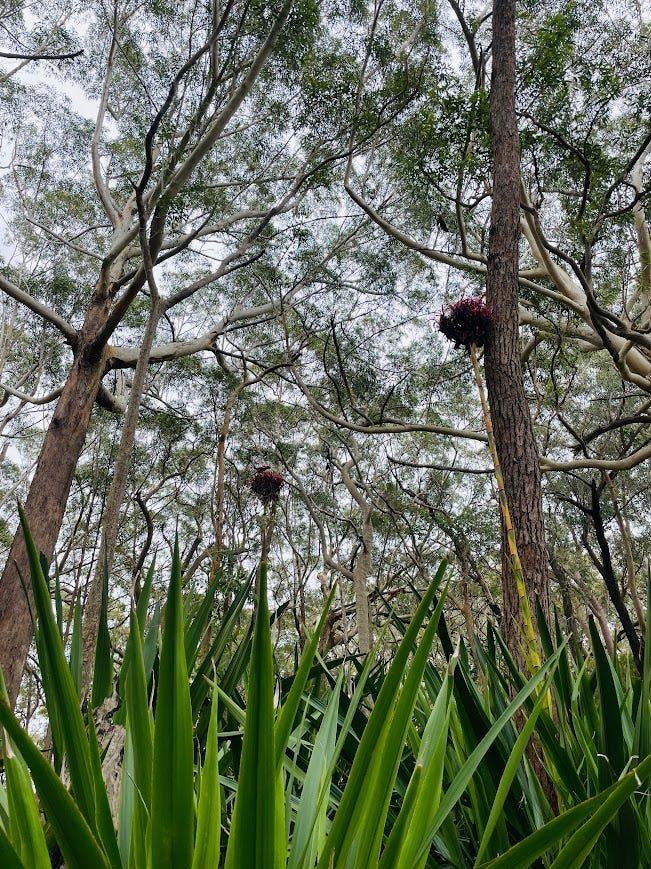
Stanwell Park is nestled in a small valley, creating an absolutely stunning viewpoint from above. The town’s main claim to fame is being the home of Lawrence Hargrave, who is sometimes considered the “inventor of human flight” for his flying machines that preceded the first airplane. Stanwell Park is famous for hang gliding and paragliding, given that its location between sea cliffs makes for great conditions and idyllic views. We’ve had the pleasure of learning more about the town given that our host wrote a lovely book about its Aboriginal history, colonial history, and his life there.
In a familiar story to those we had encountered in New Zealand, the native littoral rainforest was torn down in the early 1900s. As restoration efforts began, invasive plants were a threat to the regenerating rainforest. Our host had found an incredibly creative solution to dealing with the excess of dead weeds. He turned them into giant nests! Spread across the forest floor, this debris built up and created more fire risk in an already vulnerable area. But clustered together, they provide compost for the regenerating trees and shelter for forest creatures. They also reduce fire risk by reducing airflow and retaining wet centers. The nests alone are a whimsical addition to the forest, but the “eggs” make them even better! An avid potter, our host makes and paints many of the eggs himself, but he also involves local schoolchildren! In 2020, they created a series of eggs based on famous artworks for people to enjoy while art galleries were closed. There are also about 20 eggs that look like baby dinosaur hatchlings! We helped reinforce any deteriorating nests and planted 30 bush cherry trees. We found the project really touching, and couldn’t have asked for a better intersection of conservation, education, and the arts.
We were also incredibly lucky to get to see more of the region on a trip to our host’s other property near Ulladulla, about two hours down the coast. He owns a large plot of land, mostly dedicated for conservation. The entire property had burned during the 2020 fires, and it was wild to see how quickly the eucalyptus trees had regrown from charred trunks. We helped pare back invasive plants so that they wouldn’t outcompete native species. The property is also home to a herd of wild, but tame kangaroos. Sometimes when kangaroos are hit by cars, the joey survives in the pouch. Animal rescue groups had reached out to our host since his property would be a safe place to relocate them. The kangaroos we met were descendants of these original joeys! I couldn’t believe my luck. Seeing little joeys hopping outside of the pouch just a few feet away was an absolutely magical experience I will never forget. There are few things I’ve dreamed of for such a long time. Encountering wild kangaroos in Australia after 20 years of imagining that moment can only be described as surreal.
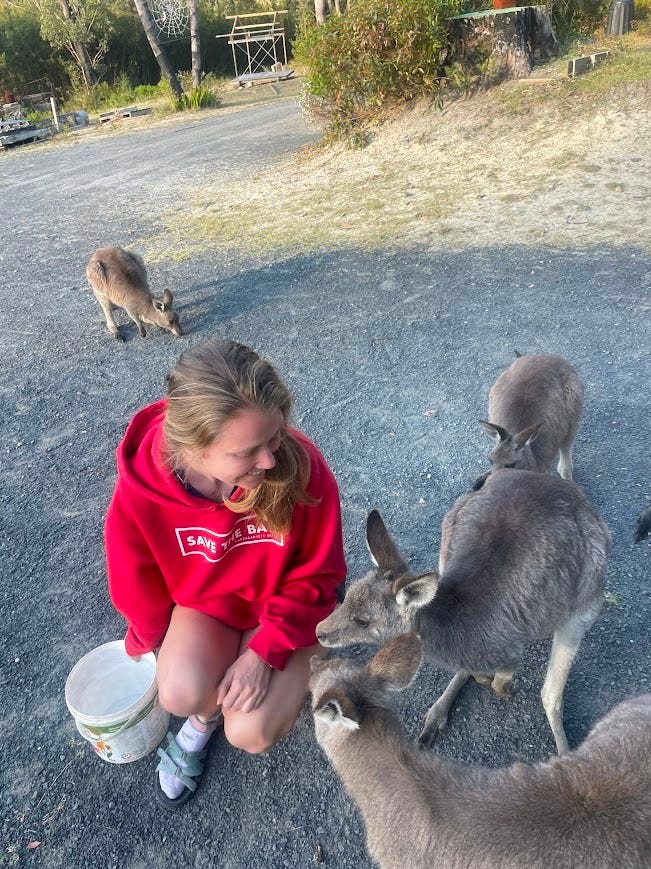
I Want to Be Retired
In my last post, I shared how taking a sabbatical has reinforced my belief in their value. People responded with a lot of great, abstract questions that prompted a few more of my own. Several folks pointed out that in academia, a sabbatical is often provided so that academics can go do more work, just in a different location or on a different project. Is it really “time off” if you are working during it? My dad helpfully reminds me that working in the service industry is the “real job,” and I bet most people who work in service would agree. If you don’t go back to a similar career/lifestyle as before, is it really a sabbatical or just a major life change? And is it really possible to imagine lives not centered around work? Even with different economic policies, isn’t some kind of work (individually or collectively) still necessary for survival and wellbeing?2
For me, the feature that defines this recess, sabbatical, or time off is a big change in my relationship to work that I define on my own terms. While most sabbaticals involve some level of increased leisure, I don’t think the experience is solely defined by whether and how much you work. Even people who love their jobs and don’t want a big long-term change could probably enjoy or be meaningfully challenged by doing something different for an extended period. The idea of having “mini-retirements,” or several, shorter periods of time off over the course of a career, is growing in popularity. People often save up resources for major goals in retirement, like travel, hobbies, more time with family/friends, or moving to a new location. But not all of these goals can be achieved at one stage of life! And even if they could, the choices I would make and experiences I would seek out would be different. Even at the young age of 29, I know I’m not going to be traveling with this giant backpack into my 60s. I think this year has been a good proof of concept! And I’d be eager to see how my 38-year old self would approach it all differently.
Who better to learn from during a mini-retirement than people who are actually retired? Whether it be a former forester who devotes his days to restoring a wetland, the volunteers at the historical library in Akaroa, our WWOOFing/Workaway hosts, or our own family members, we’ve spent a lot of this year with people who are retired/semi-retired. We feel like we’ve been observing so many aspirational models of how to live a meaningful life, in ways big and small. As I mentioned in our last post, many Kiwis have had an “overseas experience (OE)” of their own. We’ve enjoyed talking to people who have the positive memories and perspective on how their OE influenced them, but who have also lived full, rich lives since that time.
So much of my dissatisfaction in life stems from wanting things I don’t have yet. I want to be deeply rooted in a local community, and to be an expert on its human and natural histories. I want to have a home that I can make my own, with personal touches and a cat with a strong personality. I want to know the soil and weather patterns well enough that I can have an abundant garden. I want to be involved in local organizing and experience the benefits of advocating for better policies. I want to be a present neighbor and available friend. I want to be satisfied with a place I’ve chosen to settle down without that nagging itch to try on other lives. I’ve started to build a lot of these things in the places that I’ve lived. But I simply haven’t lived anywhere long enough (or been alive long enough) to have a deep knowledge of and rootedness in a place.
Our time in the bush has really driven this home. We have seen so many MASSIVE, old trees during our travels. On the wetland project, we weeded to support regrowth of native tōtara and kauri trees that can grow well over 100 feet tall. In the Whakarewarewa Forest, we walked on swinging-bridges under California redwoods (over 200 feet tall!) that have integrated into the forest in a way that provides a welcome canopy for native ferns. On Tiritiri Matangi, we met volunteers who have helped transform the island back to native bush over 50+ years. On our various conservation projects, we have planted quite a few trees! Often, placards will include a photo of the area from generations prior. I gape at these majestic forests and imagine what it would be like to see the landscape transformed so dramatically over the course of my life. As I work alongside people who know a place intimately and will see it into future stages, I feel humbled at the opportunity to be here at this snapshot in time.
While I admire the special people for whom everything just seems to come together at a young age, most people, like trees, develop their rootedness more gradually. In the prologue of his book, our Stanwell Park host comments, “The precise stage in which one becomes a local is vague, but after 50 years living in Stanwell Park. . . I think I have completed my apprenticeship.” These are the things you build over the course of a life, such that by the time you retire and welcome two bushy-tailed backpackers into your home, it seems like you’ve always lived this life of comfort, community, and self-fulfillment. I have to remind myself that I don’t want to be retired yet! I can be patient and enjoy the process as I build towards becoming the person I aspire to be.
This year, I am less physically rooted than ever, and I’m grateful for that freedom. But even as I move around literally weekly, I can still see the seeds I am planting. I am gathering inspiration for when I’m ready to live a life that is more rooted, along with the confidence that I’ll be able to create a version of these abstract desires for a beautiful life that is uniquely my own.
What’s next?
We’ve reunited with our campervan, which provides the free, easy accommodation that makes our travels possible. Though wish us luck, because we’ll be selling it soon! High tourism season in New Zealand is quickly arriving, which will mean we can hopefully sell our van for a decent price. In the meantime, we’ll be basing ourselves in Tauranga for a few weeks. We’ll be cat-sitting and taking free pottery classes in exchange for light volunteering around the studio. I’ve also been dabbling in writing some short stories and journalistic pieces. While we had hoped to get paid work, our imminent backpacking trips don’t give us quite enough time for most gigs. After some reflection, we’ve concluded that our weeks volunteering have been major highlights of our year, and we’ll seek out more to fill the remaining time before our Great Walks. More soon!
Workaway is similar to WWOOFing, but is focused on a variety of language and cultural exchanges beyond just organic farms/gardens.
And of course there’s the issue of making a sabbatical work financially. While I do think we’ve designed our extended travel quite cheaply, it’s hard to imagine thriving on a sabbatical while already dealing with financial stress with a job. Having paid sabbaticals for all types of work/levels of income would make sabbaticals of all kinds possible for more people. And in some countries, this isn’t that radical. In Australia and New Zealand, employees who complete an extended period of service with an employer are entitled to “long service leave (LSL).” This period of extended time off is paid at their normal salary, in addition to their regular 4+ weeks paid time off. Even as contracted service workers, we got 8% added to every paycheck to account for our owed “holiday pay.” For some service, construction, and community services industries, time worked towards an LSL is even portable across employers. It’s not a perfect system, and hasn’t been updated to reflect changes in the labor market, like people switching jobs more frequently. But it shows that working with no extended break for 40+ years before retirement doesn’t have to be the only way to structure employees’ relationship to work.

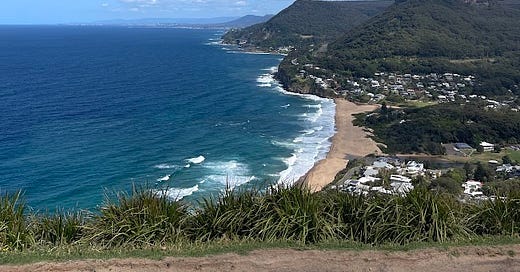



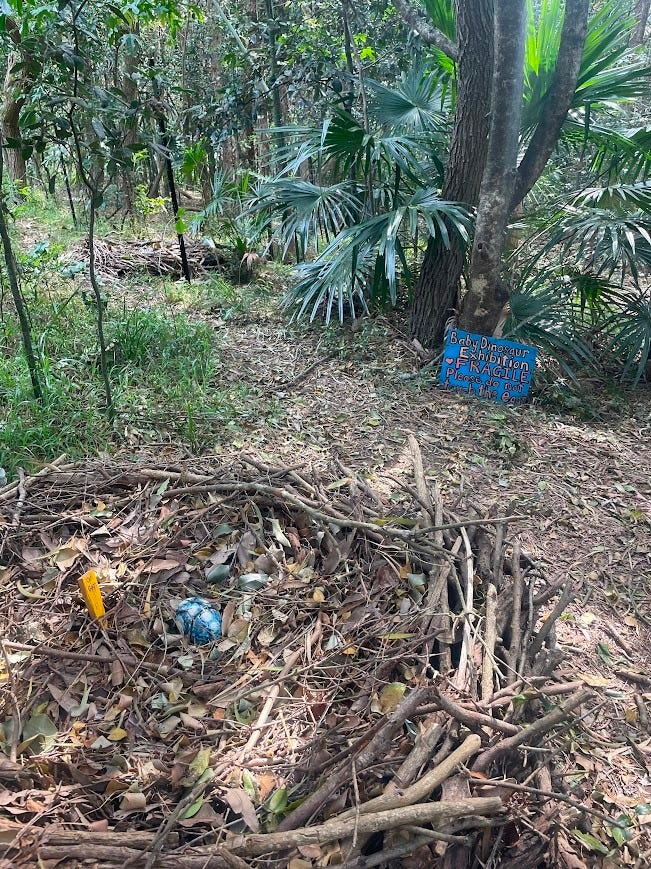

THE PAINTED EGGS IN NESTS COMBINING CONSERVATION AND THE ARTS ARE YOU KIDDING ME
also "even as I move around literally weekly, I can still see the seeds I am planting. I am gathering inspiration for when I’m ready to live a life that is more rooted, along with the confidence that I’ll be able to create a version of these abstract desires for a beautiful life that is uniquely my own." very much relate to this! I've lived a pretty transient life so far, but I see it as being in service to a confidently rooted life later. thanks for putting this into words!